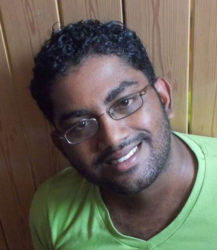 The National School of Theatre Arts and Drama (NSTAD) staged Performance 5: Ritual at the National Cultural Centre last week Sunday night, in which it showed off the work of its students.
The National School of Theatre Arts and Drama (NSTAD) staged Performance 5: Ritual at the National Cultural Centre last week Sunday night, in which it showed off the work of its students.
That presentation belonged to a series of productions known as The Performance mounted by the School of Drama, and it is striving to become a tradition on the Guyanese stage. It has achieved regularity, credibility and artistic strength, but when it comes to establishing an audience or creating an audience of its own it is not quite there yet.

This series of public productions is entirely the work of students of the NSTAD, one of the four colleges of the Institute of Creative Arts. It has a number of objectives. Students are learning production and performance, and putting their work before the public is a test of their competence to mount a production, as well as of their artistic capacity. They are trained in several areas of stagecraft, performance and management and putting these in practice in two major productions annually is part of their practical examination.
Since it started to seek an institutional identity and a national stage personality by calling itself The Performance, the series has had a regular record of two productions each year since 2014. Before that, the class of 2013 produced the first public exhibition of students’ work when they did an excerpt from Sophocles’ Greek tragedy Antigone along with pieces developed from improvisation and an extract from the traditional Ramlila as it is performed by the folk in the Caribbean. That was followed by a short adaptation from Harold Bascom’s Makantali, which they took to Carifesta XI in Surinam.
Then in 2014 there emerged The Performance (going by that name), which was a selection of pieces developed in course-work, followed by The Performance 2, whose main drama was Pandora’s Box written by the students from a concept by the Director of NSTAD. The series had then found its feet and the Class of 2015 continued with the third edition which included two pieces of Greek theatre: Agamemnon (from Aeschylus) and their own adaptation of Sophocles’ Oedipus Rex called Fate. They then continued to exhibit their rapidly developing independent creative imagination by adding sub-titles which reflected the thematic concept behind each production. Their next stage work in 2015 was Performance 4: The Resurrection.
For this there were new plays written by the students – a more polished repeat of Ramlila by Subraj Singh adapted from Tulsidas’ Ramayana, and the musical Kwe Kwe also written by Singh. These were performed alongside The Emotions, again the original work of students within the NSTAD Director’s concept.
This developing direction was intensified in the first 2016 production. The thematic identification was continued through the title Performance 5: Rituals. They also reinforced the practice of presenting original student work. Two pieces were ritualistic – Spirits directed by Yashwantie Rampertap and Legend of Kako directed by Frederick Minty – and were developed in class; while Everyman’s End, was a play especially written for the production. The pieces performed were therefore representing ritualistic theatre that they investigated in the course History of the Stage. There, they were also demonstrating two theatrical types. The first was a style of performance taken from traditional ritual and myth belonging to traditional societies.
Performance 5: Rituals was therefore a virtual mini-festival of students’ work and research. More than that, it was virtually a Subraj Singh festival since so many examples of his work were on show. In the production of new and original work by NSTAD students, Singh has been most prolific, and his work has been repeatedly performed by the Class of 2015 and now again by those in 2016. He graduated from NSTAD with distinction as the Best Graduating Student in the Institute of Creative Arts and is now a member of the National Drama Company. He had also graduated in English at the top of his class at the University of Guyana, and is also now a Tutor at the NSTAD.
In this production last week Singh wrote three of the dramas performed. Spirits was developed in the History of Drama course where students improvised pieces based on traditional practice, storytelling, myths, rituals, and spiritual beliefs. These arose from the theory of ritual origin which holds that theatre began in pre-historic or traditional religious ritual and ceremonies. In this case, Singh’s script was written for use by the class as their test piece and kept faithful to the kind of ritualistic theatre.
Everyman’s End was written by Singh for the class to fulfil the requirement for an example of a Morality play. This was another dramatic type that they studied. Morality plays, or Moralities, evolved in the Mediaeval Age after the Roman Catholic Church had given new life to drama to educate the people about Christianity since they could not read the Bible. But after theatre moved out into the towns and secular communities to entertain people and earn fees, Christianity still influenced popular thinking. The Morality plays focused on the life of “Everyman”, the central character who went through life having to choose between salvation by the angels and damnation by the devils.
Everyman’s End was performed as a part of Performance 5: Rituals by the class directed by Quincy Richards who was also production manager with Stage Manager Donna Sargeant. The central character Old Everyman (Frederick Minty) has to answer for his life and be judged by the Demon (Vernon Bennons), the Angel (Tristana Roberts) and Death (Colleen Humphrey). This life examination takes the drama back to the bad deeds of Everyman in his youth (Nelan Benjamin), using Wealth (Dolissa Sookram), Knowledge (Yashwantie Rampertab) and Good Looks (Uso Telford) to exploit a shepherdess (Tikoma Austin). The hero (Ato Vaughn) is further condemned by his ill-treatment of a Countess (Twyla Sealy) and of his wife (Padmini Narine). The final testimony of Good Deeds (Tomika Lewis) reveals that he had performed none; he is condemned to hell and dragged off by tormenting demons. The cast is completed by Abigail Robertson, Ackeeni Bentinck, Lakeisha Adams, Indira Itwaru, Ashmini Morlyn-Shaw, Jamal Omawali, Zola Telford and Ruqayyah Boyer. This reflects the typical central theme of the morality drama.
The musical play Kwe Kwe, first written by Singh for the 2015 performance The Resurrection, was directed by Ayanna Waddell and performed by the National Drama Company. This was a drama dominated by the revelry, abandon and gaiety of celebrants at a traditional kwe kwe at the home of the bride until there is a major dramatic twist at the end which transforms the ceremony into a spiritual and tragic one. It is laced with a sequence of songs in the kwe kwe (kwe ke or kakalay) tradition, with dance and some ritual. It plays on the elaborate plans, which according to poet Robert Burns “gang aft agley” (the words from his poem are often translated as “the best laid plans of mice and men oft go astray”), showing those elaborate plans for a wedding which turn to grief. The play’s irony is the thin line between joyous celebration and tragedy, while also playing on the spiritual side of the kwe kwe ceremony.
What is to be noted in these performances by the NSTAD and by the National Drama Company is the way they demonstrate new and varied forms of theatre, explore paths away from the ordinary and show what many things are possible on stage. In the student productions it was seen how, although they are students learning the craft they do not lag behind what prevails on the commercial stage of their seniors.
The great irony in all that is that the vast majority of the local audience for theatre does not come out to see these students. They are therefore untutored in the alternative forms of theatre that the NSTAD and the Drama Company study and lose quite a worthy experience in the theatre.





